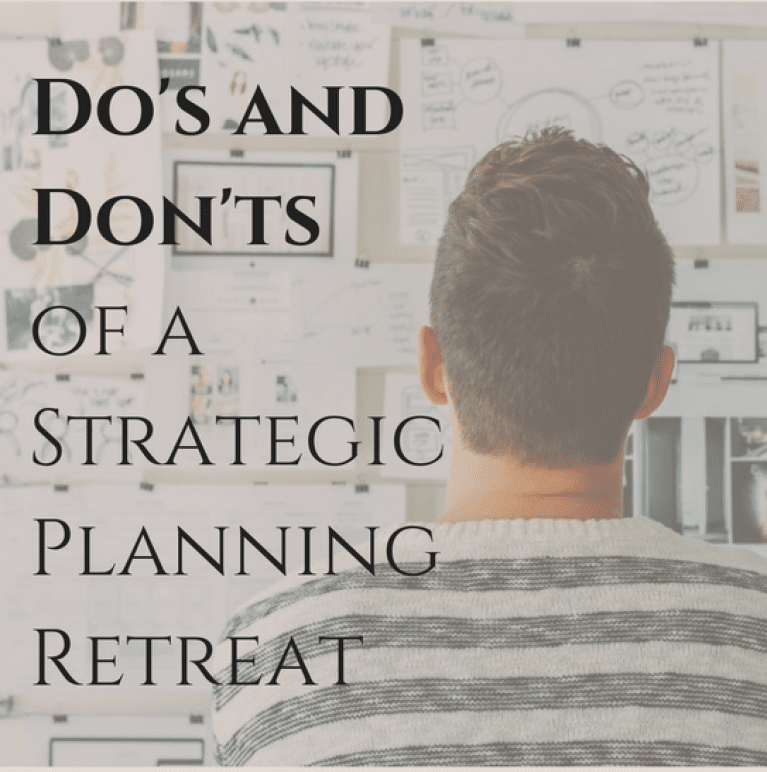
The Standards for Excellence® Code identifies specific benchmarks and measures that provide objective standards and best practices on how a nonprofit should operate. According to the code, “nonprofits should engage in ongoing long and short-term strategic planning activities as necessary to determine the mission of the organization, to define specific goals and objectives related to the mission, and to evaluate the success of the organization’s programs toward achieving the mission.”
Unfortunately, many strategic planning retreats end up, at best, as a temporary exercise with little follow-up momentum and at worst, a train wreck where previously unknown organizational and board issues bubble to the surface.
The success or failure of a strategic planning retreat can lie in the hands of the group facilitator, who must deeply understand the organization that they are guiding. Simply having the tools and resources to lead a retreat are not enough; a successful group leader is aware of the organization’s history and the personal dynamics of the group.
Many years ago, I participated in a board retreat where the facilitator was well-meaning but basically incompetent. They unintentionally pitted two board members against the executive director, resulting in a permanent rift that led to resignations and years of rebuilding for the organization. Not good. Time, resources and energy are so often limited for retreats, so it is crucial to choose the right facilitator – one with experience, process, people skills, and intuition – to keep the agenda on track.
All too often, strategic planning retreats go awry. However, when done right, they can be a morale boost, momentum builder and galvanizing force for a nonprofit to create a strategic plan that is accessible, visionary and most importantly, useful to the organization. Fortunately, executive directors, staff, and board can plan for an effective strategic planning retreat by taking some easy yet critical steps:
Before the retreat…
1. Vet the facilitator.
Choose a Licensed Consultant from the Standards for Excellence Institute® and ask for references and previous retreat experience. It is not enough for a facilitator to have a good process or be an “expert”. They must be engaging and be able to read the energy in the room.
Attendees can be nodding their head “yes” while meaning “no” or feel intimidated about speaking up. I see many facilitators who are clueless about the psychological and social components of a retreat. Fatigue issues and personal chemistry can affect progress, and this may go unnoticed by a facilitator barreling through a SWOT analysis or group survey.
A good retreat leader knows three things: a) the organization he/she serves b) the essential core of the strategic planning process, and c) a little about human relations and psychology to navigate the dynamics in the room.
2. Check expectations.
Strategic planning retreats aim to solve complex problems and create guidelines and programs for the future. However, not everything can be accomplished in just a one- or two-day retreat. While an organization can get a good start through the retreat process, producing a strategic plan takes many hours of “offline” work. The strategic planning process goes on as team members continue planning, haggling, communicating with board members, and soul-searching.
During the retreat…
1. “Be the guide on the side, not the sage on the stage.”
Facilitators should take moments to step aside, offering helpful guidelines to move the conversation forward. Setting parameters for discussion, using interesting and interactive tools that get people moving and generating ideas, and establishing mutually agreed upon rules for constructive dialogue can be helpful activities for retreats.
2. Don’t let the loudest voice in the room dominate the discussion.
It is critical for ALL board members and staff to speak up and be heard in the retreat. Get the conversation started by eliciting verbal or written contributions in both small and large discussion groups. All too often, the loudest voice drowns out those with valuable perspectives, leading to hurt feelings, frustration and a strategic plan that is good-looking but lacking in its full potential.
3. Capture no more than 5 essential strategic points.
A strategic planning session should “under-promise and over-deliver” rather than be a shopping spree of new initiatives. Focus on fewer high-quality goals, rather than an abundance of strategic directions that go unfulfilled.
A good retreat facilitator will gently probe and push attendees to refine and define their thinking – not to lock it into place, but to clarify it. In this way, attendees can leave the retreat with stronger drive to pursue a small number of strategic points.
4. Be aware of “saturation points.”
Strategic planning is exhausting! Frequent breaks and interactive activities that involve movement and stations will ensure that attendees feel energized, acknowledged, and attentive.
5. Avoid getting “into the weeds” on any one issue without a resolution or time limit.
A strategic planning retreat should never devolve into a gripe session or focus too much on what hasn’t worked in the past. While it is critical to analyze past performance, it is human nature to become bogged down in details that happened yesterday rather than envision a future that will propel the organization forward.
After the retreat…
1. Organize and disseminate notes as soon as possible.
The board chair and executive director should follow-up almost immediately with attendees to be sure that all voices were heard, that there aren’t any bruised egos, and that all that needed to be said was said. Without this step, the entire process can be derailed.
2. Review observations with the group facilitator.
Check in the with the facilitator for overall comments, observations on personal and group dynamics, and next steps. By analyzing the highs and lows of your group session, you can ensure the success of future retreats.
3. Begin formulating your strategic plan.
Assign and schedule board members with excellent writing and organizational skills to begin the difficult process of taking the strategic direction notes and formulating them into a plan.
There are many more subtleties of a strategic planning retreat and the actual process than space allows, but I wanted to capture some of the essential “should and should-nots” of an actual retreat. Armed with this information, your organization can maximize the precious time, energy and resources of board and staff and begin the path to creating a truly useful and visionary strategic plan.
Choosing a competent facilitator can make all the difference in your strategic planning retreat. Choose a group leader that helps you to fulfill your mission and vision, build better relationships between your staff, and strategize to create a strong future for your organization. Standards for Excellence Institute Licensed Consultants can ensure that your strategic planning session is a success. Find a Licensed Consultant near you today!
 Rob Rob Levit is a Standards for Excellence® Licensed Consultant.
Rob Rob Levit is a Standards for Excellence® Licensed Consultant.



